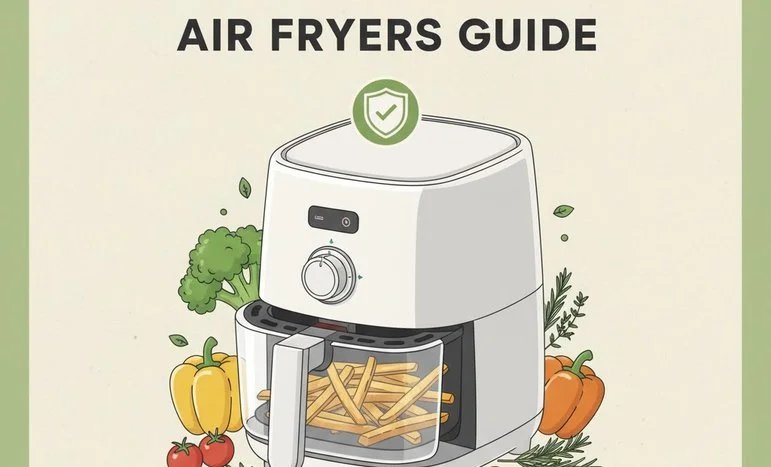
What are Non-Toxic Air Fryers and How to Choose One?
Introduction
Non-toxic air fryers have emerged as a cornerstone of health-conscious cooking. Using advanced hot air circulation technology, they fry food with little to no oil—without exposing users to the harmful chemicals found in many traditional non-stick coatings.
As wellness-focused consumers grow wary of toxic kitchenware, search interest for non-toxic air fryers has skyrocketed by 3,450%, signaling a broader shift toward safer, cleaner, and more sustainable cooking practices.
What Makes an Air Fryer “Non-Toxic”?
A non-toxic air fryer is built with chemical-free, food-safe materials designed to eliminate exposure to potentially hazardous substances like PFOA (perfluorooctanoic acid) and PTFE (polytetrafluoroethylene)—the latter commonly known as Teflon.
Instead, these models use coatings such as:
- Ceramic – naturally non-stick, resistant to scratching, and free from synthetic chemicals
- Stainless steel – highly durable, easy to clean, and inert under high heat
Both materials ensure chemical stability, meaning they don’t leach harmful particles or gases during cooking.
Why Avoid PFOA and PTFE?
Traditional non-stick coatings that use PFOA or PTFE can release toxic fumes when overheated—posing health risks and environmental concerns.
Over time, such coatings may flake, leading to chemical ingestion or inhalation. In contrast, non-toxic air fryers maintain performance and safety without those risks, making them ideal for homes seeking long-term health benefits.
Benefits of Non-Toxic Air Fryers
1. Healthier Cooking
By avoiding hazardous coatings and using minimal oil, non-toxic air fryers support cleaner eating habits. Food retains its crisp texture without added fats or toxins.
2. Durability and Longevity
Ceramic and stainless steel surfaces are more scratch-resistant and heat-tolerant than typical non-stick coatings, extending the appliance’s lifespan.
3. Eco-Friendly Choice
Chemical-free coatings reduce manufacturing waste and environmental pollution. Many brands now use recyclable materials and energy-efficient heating systems.
4. Better Flavor Retention
These air fryers circulate hot air evenly, ensuring a consistent crispness and preserving the food’s natural flavor without the plastic-like aftertaste sometimes caused by synthetic coatings.
How to Choose the Right Non-Toxic Air Fryer
1. Check for Certifications
Ensure the product is labeled “PTFE-free”, “PFOA-free”, or “non-toxic certified.” Trusted safety standards come from organizations such as FDA, LFGB, and RoHS.
2. Material Matters
Opt for ceramic-coated or stainless-steel baskets and interiors. Avoid ambiguous terms like “non-stick” unless the material composition is clearly stated.
3. Power and Efficiency
Choose a unit with at least 1,500 watts of power for efficient, even cooking. Higher wattage ensures faster heat circulation and crispier results.
4. Read User Reviews
Look for feedback about heat distribution, ease of cleaning, and long-term performance. Real-world reviews often reveal hidden strengths—or weaknesses—beyond manufacturer claims.
5. Ease of Maintenance
Select models with removable baskets and dishwasher-safe components. Smooth ceramic surfaces often clean easier than metal mesh baskets, reducing residue buildup.
Popular Non-Toxic Air Fryer Materials: A Quick Comparison
| Material | Key Features | Safety Level | Maintenance |
|---|---|---|---|
| Ceramic | Non-stick, scratch-resistant | ✅ Excellent | Easy to clean |
| Stainless Steel | Durable, long-lasting | ✅ Excellent | Requires wiping after each use |
| Glass | Chemical-free, visible cooking | ✅ Excellent | Fragile and rare in models |
Everyday Use Tips
- Preheat properly for even crisping
- Avoid metal utensils that might damage coatings
- Wipe interior after every use to preserve material integrity
- Use parchment paper liners to prevent food sticking naturally
The Market Shift Toward Safer Appliances
The rise of non-toxic air fryers mirrors the global movement toward conscious consumerism—where health, sustainability, and transparency shape purchasing decisions.
Brands are responding with innovation in materials science, producing devices that prioritize both safety and performance. This marks a significant evolution from convenience-focused gadgets to wellness-oriented design.
Non-toxic air fryers redefine modern home cooking—combining safety, convenience, and sustainability. By using PFOA- and PTFE-free materials like ceramic or stainless steel, these appliances empower users to enjoy their favorite fried foods without compromising health or taste.
When choosing one, prioritize certifications, power efficiency, and verified material safety. A well-selected non-toxic air fryer isn’t just another kitchen gadget—it’s an investment in long-term wellness and clean, guilt-free cooking.
We appreciate that not everyone can afford to pay for Views right now. That’s why we choose to keep our journalism open for everyone. If this is you, please continue to read for free.
But if you can, can we count on your support at this perilous time? Here are three good reasons to make the choice to fund us today.
1. Our quality, investigative journalism is a scrutinising force.
2. We are independent and have no billionaire owner controlling what we do, so your money directly powers our reporting.
3. It doesn’t cost much, and takes less time than it took to read this message.
Choose to support open, independent journalism on a monthly basis. Thank you.













